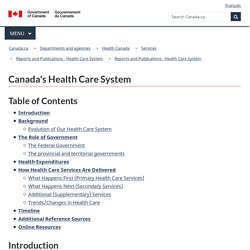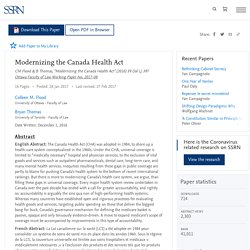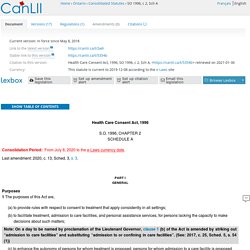

Home - College of Occupational Therapists of Ontario. Homepage - Canadian Association of Occupational Therapists. Occupational Therapy Act, 1991. CNO - Regulation, Legislation & By-Laws for Nurses. CNO Standards & Guidelines. Nursing Act, 1991. Regulated Health Professions Act, 1991. Personal Health Information Protection Act - PHIPA 2004. Registered_nurses_stepping_up_to_transform_health_care_e. Canada's Healthcare System Explained! The Truth About Canadian Healthcare. Organization of the Health System in Canada. Canada's Health Care System Explained. Table of Contents Introduction Canada's publicly funded health care system is dynamic--reforms have been made over the past four decades and will continue in response to changes within medicine and throughout society.

The basics, however, remain the same--universal coverage for medically necessary health care services provided on the basis of need, rather than the ability to pay. Background The basic values of fairness and equity that are demonstrated by the willingness of Canadians to share resources and responsibility are displayed in Canada's health care system, and have been reflected in the modifications and major reforms made to the system since its inception. Evolution of Our Health Care System In general, Canada's Constitution sets out the powers of the federal and the provincial and territorial governments.
Canada's Universal Health Care System. If you are a Canadian citizen or permanent resident, you may apply for public health insurance.

With it, you don’t have to pay for most health-care services. The universal health-care system is paid for through taxes. When you use public health-care services, you must show your health insurance card to the hospital or medical clinic. Each province and territory has their own health insurance plan. Make sure you know what your plan covers. Commonwealth Fund. Physician education and workforce: Students who obtained a medical degree from one of Canada’s 17 public medical schools paid an average annual tuition of CAD 14,780 (USD 11,730) in 2018–2019.10 About 27 percent of Canada’s physicians received their degree outside Canada.11 In 2017, 92 percent of physicians practiced in urban locations.12 There are no national programs to ensure a supply of doctors in rural and remote locations.

However, most provinces have rural practice initiatives. For example, Alberta’s Rural, Remote, Northern Program guarantees physicians an income greater than CAD 50,000 (USD 39,382).13 Primary care: In 2017, there were 2.3 practicing physicians per 1,000 population; about half (1.2 per 1,000 population) were family physicians, or general practitioners (GPs), and the rest specialists (1.15 per 1,000 population).14 GPs act largely as gatekeepers, and many provinces pay lower fees to specialists for non-referred consultations. Canada Health Act & It's Principles. Canada Health Act Fact Sheet. Canada Health Act - Links to Provincial and Territorial Health Care Web Resources. Modernizing the Canada Health Act by Colleen M. Flood, Bryan Thomas.
Abstract English Abstract: The Canada Health Act (CHA) was adopted in 1984, to shore up a health-care system conceptualized in the 1960s.

Under the CHA, universal coverage is limited to “medically necessary” hospital and physician services, to the exclusion of vital goods and services such as outpatient pharmaceuticals, dental care, long-term care, and many mental health services. Inequities resulting from these gaps in public coverage are partly to blame for pushing Canada’s health system to the bottom of recent international rankings. But there is more to modernizing Canada’s health care system, we argue, than filling these gaps in universal coverage.
Every major health system review undertaken in Canada over the past decade has ended with a call for greater accountability, and rightly so: accountability is arguably the sine qua non of high-performing health systems. Ontario Ministry of Health Legislation. Health Care Consent Act, 1996. Health Care Consent Act, 1996 S.O. 1996, Chapter 2 Schedule A Consolidation Period: From July 8, 2020 to the e-Laws currency date.

Purposes 1 The purposes of this Act are, (a) to provide rules with respect to consent to treatment that apply consistently in all settings; (b) to facilitate treatment, admission to care facilities, and personal assistance services, for persons lacking the capacity to make decisions about such matters; Note: On a day to be named by proclamation of the Lieutenant Governor, clause 1 (b) of the Act is amended by striking out “admission to care facilities” and substituting “admission to or confining in care facilities”.
(c) to enhance the autonomy of persons for whom treatment is proposed, persons for whom admission to a care facility is proposed and persons who are to receive personal assistance services by, (i) allowing those who have been found to be incapable to apply to a tribunal for a review of the finding, Interpretation.